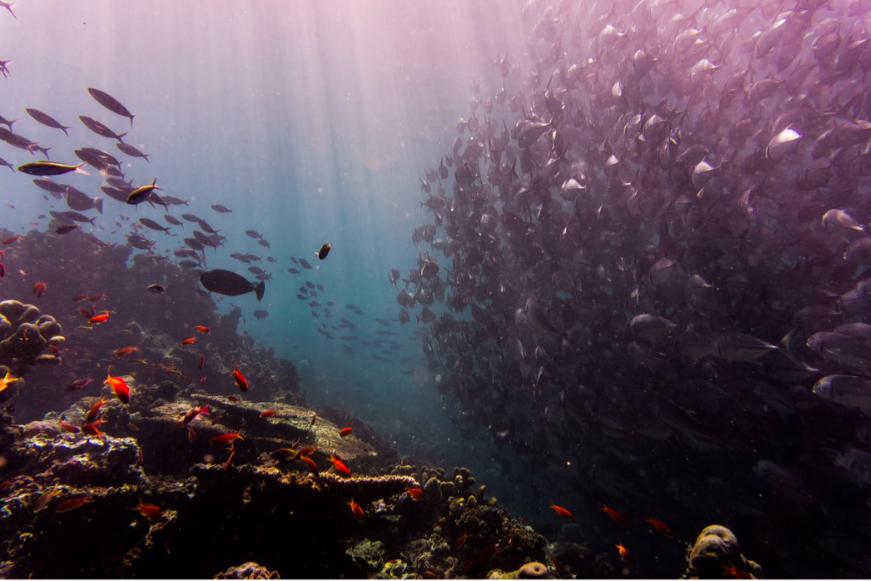Countries need to produce more food on less land in the years ahead, otherwise world hunger and the climate crisis will continue to get worse.
That’s the succinct yet staggeringly complex conclusion of a new report by the World Resources Institute, the World Bank, and the United Nations.
Reforming the global food system requires overhauling how food is produced, managed, and consumed. The report explores three main gaps that the world has to overcome on its way toward a better food system — the food gap, the land use gap, and the greenhouse gas emissions gap — that all boil down to sustainability.
By 2050, the global population will reach nearly 10 billion people and global food demand will soar by 56%. If food trends continue unchanged, 593 million additional hectares of land, equivalent in size to two Indias, would have to be cleared and converted to crop and livestock production to feed this many people. But the report warns that no more land can be set aside for food production — the earth simply can’t withstand further degradation.
Instead, huge swaths of land currently being used to generate food have to be returned to their wild state to protect the planet from irreversible decline.
“The challenge is bigger than is commonly appreciated,” Richard Waite, associate at World Resources Institute’s Food Program, told Global Citizen. “That said, there is a path towards solving it, but it will require the world to do some of everything.
“There’s 30 more planting seasons between now and the year 2050,” he said. “We don’t have much time to close those gaps.”
Read More: 7 Staggering Facts From the UN's New Report on Hunger
The report describes 22 solutions for achieving a more sustainable food system that fall into five broad categories.
The first set of solutions addresses the question of how to feed more people while reducing the overall demand for food, a seemingly contradictory goal. In recent years, demand for resource-intensive foods such as red meat has grown beyond the level of the planet to sustainably provide these foods. More broadly, the world is depleting the earth’s resources at a rate that outstrips the planet’s ability to regenerate itself.
There are ways, however, to grow more food, while using less resources, Waite said.

“We’re not saying that everyone has to go vegan or vegetarian, but, instead, moderating consumption of beef and shifting to more plant-based foods,” he said.
If people around the world — especially in countries like the US — ate less meat and instead got more of their calories from crops, more calories could be grown on the land currently set aside for food production. In fact, producing a gram of animal-based protein requires 20 times more land and water than producing a gram of plant-based protein, the report notes.
Reducing food loss and waste is another way to limit demand. Globally, more than one-third of all food is either lost or wasted on the way from the farm to a person’s plate. Better management of food across supply chains will go a long way toward both ending world hunger and easing the resource burden on the global environment.
Read More: 9 Reasons Why Plant-Based Meat Is the Food of the Future
The next set of solutions deals with efficient land use. Farmers can cultivate more food on their land by planting different crops at different times of the year. This could allow farmers to earn more income, improve food security, and promote healthy environments by not expanding the amount of land being cleared for use.
Farmers can also improve irrigation techniques to minimize how much water they use on an annual basis. Nearly 70% of fresh water goes to agricultural purposes. As climate change strains water sources, making the most out of limited water supplies will be key to public health and environmental sustainability. Farmers can install water monitoring technology to more efficiently irrigate their crops at the right times.
Countries also have to restore ecosystems that have been depleted by agriculture, especially wetlands and forests. The biggest driver of deforestation globally is agriculture, which ironically ends up harming food production. Forests help to regulate the climate, water sources, and pests. As forests decline, droughts and desertification become more common, making it harder to grow food and raise livestock.

Read More: This Company Has a Plan to Pull All the Excess Carbon Out of the Atmosphere
The report calls on countries to restore hundreds of millions of hectares of forest to protect the planet.
By restoring natural environments, countries can mitigate climate change and cultivate more food, but only if crops that require minimal resources and provide a lot of calories are prioritized.
Restoring fish stocks is another area of focus. A third of all fish stocks are overcaught, and another 60% are being caught at their maximum sustainable level. Fish is a critical source of protein for billions of people globally, and the amount of fish consumed annually will only grow as the global population climbs.
Waite said that fish farms can be used to boost annual output, while also allowing wild fish populations to recover.

Read More: Environmental Hero Leonardo DiCaprio Wants to Change the Way You Eat Seafood
Finally, the global food system has to drastically reduce its greenhouse gas emissions. Currently, agricultural and related land uses account for roughly a quarter of all greenhouse gas emissions. Keeping temperatures from rising above the 1.5 degrees Celsius limit set by the Paris climate agreement will require food production to cut emissions by nearly 75%.
Every solution canvassed in the report limits emissions to some extent, from reducing food waste to shifting diets to restoring peatlands.
The report suggests a range of ways that farmers and livestock owners can reduce their emissions. For example, livestock owners can invest in technologies and feed additives that reduce the methane released by cows. Farmers, meanwhile, can adopt practices that sequester carbon and other greenhouse gas emissions in their soil.
“There are win-win solutions and actions that are both climate mitigation and adaptation,” Waite said.